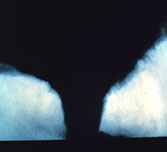Mesoscale Data Assimilation Goals
SWAP has several goals in the area of mesoscale data assimilation. One goal is to improve mesoscale analyses of severe weather events through the use of ensemble forecasting and data assimilation. SWAP is looking at perturbations in initial and boundary conditions, diversity in model physics schemes, and surface and radar observations to generate ensembles of high-resolution forecasts that can be used for data assimilation as well as quantifying the forecast uncertainty. The primary focus here is to improve mesoscale weather forecasts during the first 12 hours to access the potential for high-impact weather during this period.
SWAP scientists are using the Ensemble Kalman Filter (EnKF) data assimilation method to incorporate surface observations into the WRF model from a variety of cases. They find that assimilating surface observations for 6 hours improves subsequent forecasts of storm environment (boundaries, thermodynamic profiles, etc.) and precipitation for 6-9 hours. The data assimilation results consistently benefit from physics-scheme diversity within the WRF model ensemble.
Stormscale Data Assimilation Goals
Using multi-sensor observations, such as field program data, SWAP's goal is to produce detailed analyses of convective storms and their environments. Research includes producing detailed analyses of convective storms and their environments from multi-sensor observations. Analysis of convective storm features such as updrafts, mesocyclones, damaging surface winds, cold pools and hail and heavy rain would also help improve the understanding of the physical processes that lead to severe weather.
SWAP scientists looked at 3 supercell cases and 1 multicell case using a homogeneous initial environment in the model. Their strategy was to assimilate mesoscale and storm-scale data separately, then put the pieces together later. On one storm, the EnKF assimilated velocity and reflectivity data and results were compared with Norman radar data and tower measurements. A second experiment on a supercell used the NCOMMAS forecast model to assimilate Doppler velocity and reflectivity data. Results were verified with dual-Doppler analysis. Scientists were looking at the sensitivity of NCOMMAS to model resolution, observation resolution and precipitation-microphysics scheme. Analyses and forecasts are sensitive to almost all aspects of model and assimilation, including precipitation microphysics, observation resolution, grid resolution, and sounding estimates.
Some challenges of storm-scale data assimilation will have to be overcome including the fact that storms form through processes on a variety of scales (synoptic, meso, storm), and that there are unobserved fields (Doppler velocity, for example) that could be critical to the success of the models. Model error is a significant issue for storm-scale EnKF assimilation.

